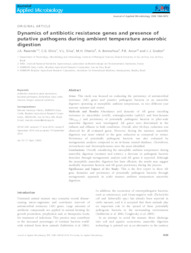Dynamics of antibiotic resistance genes and presence of putative pathogens during ambient temperature anaerobic digestion.
Dynamics of antibiotic resistance genes and presence of putative pathogens during ambient temperature anaerobic digestion.
Author(s): RESENDE, J. A.; DINIZ, C. G.; SILVA, V. L.; OTENIO, M. H.; BONNAFOUS, A.; ARCURI, P. B.; GODON, J.-J.
Summary: Aims: This study was focused on evaluating the persistency of antimicrobial resistance (AR) genes and putative pathogenic bacteria in an anaerobic digesters operating at mesophilic ambient temperature, in two different year seasons: summer and winter. Methods and Results: Abundance and dynamic of AR genes encoding resistance to macrolides (ermB), aminoglycosides (aphA2) and beta-lactams (blaTEM-1) and persistency of potentially pathogenic bacteria in pilot-scale anaerobic digesters were investigated. AR genes were determined in the influent and effluent in both conditions. Overall, after 60 days, reduction was observed for all evaluated genes. However, during the summer, anaerobic digestion was more related to the gene reduction as compared to winter. Persistency of potentially pathogenic bacteria was also evaluated by metagenomic analyses compared to an in-house created database. Clostridium, Acinetobacter and Stenotrophomonas were the most identified. Conclusions: Overall, considering the mesophilic ambient temperature during anaerobic digestion (summer and winter), a decrease in pathogenic bacteria detection through metagenomic analysis and AR genes is reported. Although the mesophilic anaerobic digestion has been efficient, the results may suggest medically important bacteria and AR genes persistency during the process. Significance and Impact of the Study: This is the first report to show AR gene dynamics and persistency of potentially pathogenic bacteria through metagenomic approach in cattle manure ambient temperature anaerobic digestion.
Publication year: 2014
Types of publication: Journal article
Unit: Embrapa Dairy Cattle
Observation
Some of Embrapa's publications are published as ePub files. To read them, use or download one of the following free software options to your computer or mobile device. Android: Google Play Books; IOS: iBooks; Windows and Linux: Calibre.
Access other publications
Access the Agricultural Research Database (BDPA) to consult Embrapa's full library collection and records.
Visit Embrapa Bookstore to purchase books and other publications sold by Embrapa.

